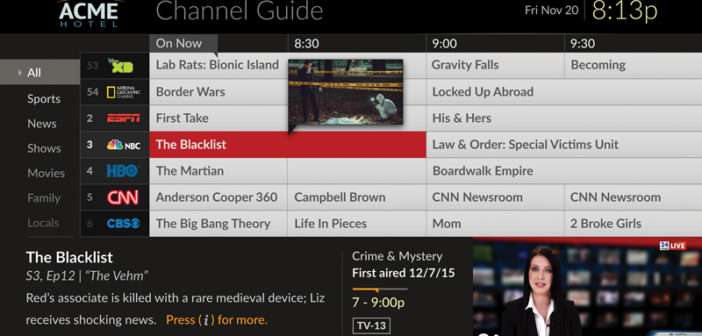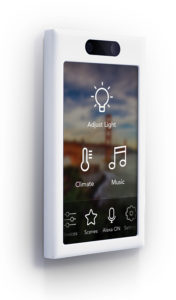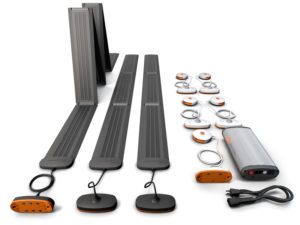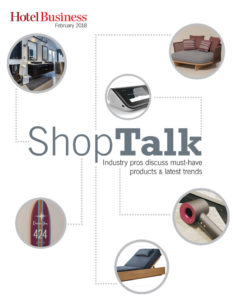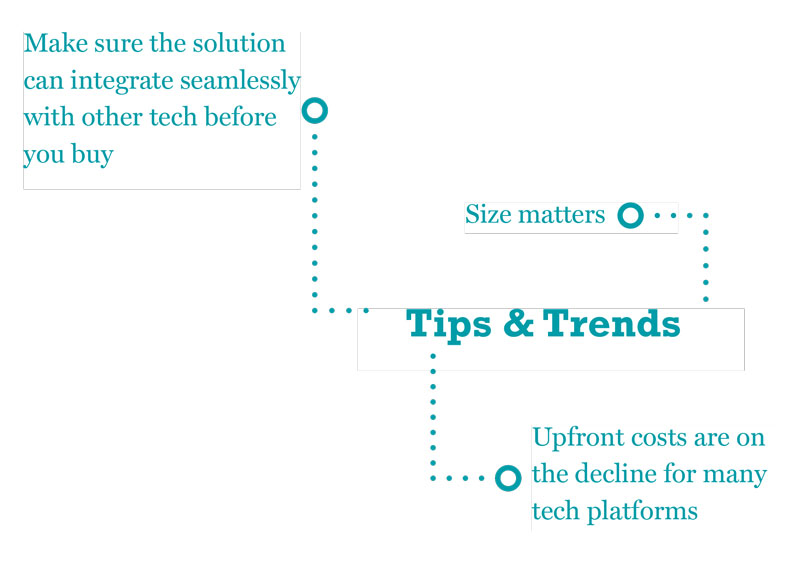 Hotel technology needs to be a well-oiled machine. Guest-facing technology like TVs shouldn’t just offer digital entertainment—they need to be integrated with in-room controls like lighting and temperature, as well as apps and services that let guests make requests on demand. And those tech solutions have other integrations that hoteliers want as well—specifically, compatibility with back-of-house operational tools that connect staff not only with each other, but with guests. And all of this needs to be housed on a robust infrastructure—one that doesn’t need to be replaced in six months.
Hotel technology needs to be a well-oiled machine. Guest-facing technology like TVs shouldn’t just offer digital entertainment—they need to be integrated with in-room controls like lighting and temperature, as well as apps and services that let guests make requests on demand. And those tech solutions have other integrations that hoteliers want as well—specifically, compatibility with back-of-house operational tools that connect staff not only with each other, but with guests. And all of this needs to be housed on a robust infrastructure—one that doesn’t need to be replaced in six months.
“Hotels have a multifaceted business model as it relates to both associate- and guest-facing technology,” said Jason K. Moll, VP, rooms, Noble House Hotels & Resorts, noting that the company expects increased complexity over the next 10 years as customer needs—and the necessary security—grow. “Given that roadmap, our preference in our technology partners is predicated on three key points: security, integration with our partners and tangible benefits—not trends.”
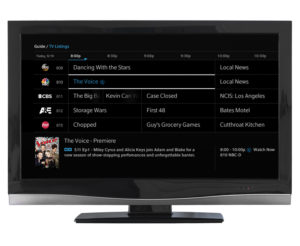
Comcast Business’ X1 for Business, coming soon, is designed to change the way hotel guests experience TV, according to the company.
“Hoteliers have tried to stay ahead of the curve when it comes to technology, but deploying new technologies can be burdensome, and it’s moving so quickly that most systems are out date shortly after they are deployed,” said Jason Cohen, VP of sales, AdcommTV. “Guests want simple solutions that enhance the guest experience, are scalable and leave a memorable and lasting impression that makes them want to come back or tell their friends about the property.”
When it comes to technology that guests use in hotels, we all know where operators and brands are putting their focus: solutions that enable guests to bring their own devices and content; a TV experience that’s as residential as possible; and the integration of room controls, concierge services and entertainment options—whether through voice, app or something else—to create a one-stop shop for the end user. But while the end result is known, how are hotels getting there?
Lori Patten, principal, Patten Purchasing LLC, noted, “When we are asked to purchase TVs or other type of media/communication items, oftentimes, we become a detective during the process… We need to be sure that all systems can communicate within the hotel; whether it be the proper voltage required, outlets/USB ports, TV systems coordinating with the property TV model, it all has to be coordinated and reviewed by the renovation team from the beginning.”
Design has to be considered. “Guests shouldn’t have to search for technology that they are intuitively familiar with,” said Marc Ciafardini, senior project designer, Wilson Associates’ Dallas Studio. “Owners should ensure that guestrooms and public spaces are incorporating technology that today’s guests would expect, as well as technology that’s universal. It should feel as comfortable to a guest as something in their home.”
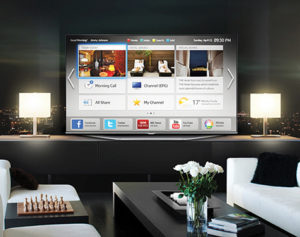
Samsung Hospitality TVs provide guests an interactive in-room entertainment experience. Equipped with Lynk Reach, a solution that allows managers to centrally control multiple screens, the HTVs can be updated remotely, allowing managers and hoteliers to deliver dynamic, customized content in a simple and cost-effective manner.
Ciafardini noted that as long as any element is properly coordinated and planned for, it won’t seem tacked on. “Design should be intrinsic and part of the story you’re trying to tell with every element,” he said. “An entertainment solution should be proportional to the surface on which it’s placed or inset. Just because something fits, doesn’t mean it’s going to look right. For instance, you wouldn’t put a 60-in. flat-screen TV in the bathroom—it just wouldn’t feel right.”
But, while it might not be right in the bathroom, certainly, a large television is something hotels are looking for in the guestroom. “Sizes are definitely increasing, and so is the guest experience via the television,” said Patten, referencing the ability to order room service or change the thermostat. She noted that some brands are “gearing up more toward 49-in. and 55-in. TV sizes, which will, in turn, have their own challenges when designing the coordinating FF&E pieces.”
Ciafardini added, “The next innovation is incorporating large-format MicroLED material into guestroom ceilings or walls for TV viewing or ambient lightscapes. I’m personally looking forward to seeing guestrooms outfitted entirely with smart motion sensor light fixtures.”
Patten noted that guests are often looking for places to charge their devices, so hotels need “more furniture designed to accommodate those requests and more creative ways to integrate power sources within the FF&E.”
For his part, Ciafardini said this could evolve, as wireless charging becomes commonplace. “I’m seeing air charging of mobile devices in guestrooms as the next hot trend,” he said, adding that this gives travelers added convenience.
Before purchasing anything, all IT should be clearly thought out. “Often, I think hotel owners and developers don’t always think about the ramifications of systems that do not interact with one another, and the extra dollars it can cost the property to go back and retrofit items due to incorrect cabling, lodging systems not property interacting with specific television types, etc.,” Patten said.
Moll noted that there are a few steps to take when purchasing technology: Network with other industry professionals, since real-time feedback from an end user is a great vetting process; involve all departments before making a decision; and don’t underestimate the configuration and interfacing costs that should be factored into project financials.
“Fortunately, the major brands do most of the heavy lifting for us and have tested and vetted the technologies,” said Reggie Piercy, SVP of operations, Vision Hospitality Group. “As a management company, we benefit from our partnerships with the major hotel brands, as technology is a slippery slope and ever changing. For hotels that do not have the benefit of a major brand backing, the heavy lifting falls back on them and that will require much homework, benchmarking and testing to ensure correct solutions are purchased that can be scaled for growth as future demands for services change. Contracting with an expert in this area can save dollars and heartache by improving both the assessment and purchasing decisions.”
Guest-facing integration with solutions designed for staff are critical for today’s hotelier. “I’m excited to see how we can introduce technology and also improve the associate/guest interactions, ultimately providing a better guest experience,” Moll said. “A majority of the tech coming out provides our customer with a more seamless ‘process’ (mobile key, mobile check-in, ordering room service from your device) and while those are all exciting enhancements, we need to challenge ourselves on how we can make the most important integration—guest-facing technology that will still allow our wonderful associates to engage with our customers to making that lasting impression.”
“New software programs have added the ability to chat with the guest via the smartphone or tablet,” Piercy added. “This has greatly improved the guest experience by improving communication between the hotel and the guest during the stay. In general, guests prefer to text than talk, and this has been a popular addition due to convenience and a paper trail that shows requests have been completed.”
“I’d like to see the airline-style ability to book and select specific rooms, upgrade and then operate guestroom features (lights, TV) and make guest requests from your own device somewhere on the horizon,” added Klaudio Simic, VP of operations, Provenance Hotels. “The potential for this type of technology to enhance the guest experience and streamline operations is incredibly exciting.”
Of course, all of these sophisticated tools—on the back end and the front end—will mean a greater need for connectivity. “Bandwidth will be stretched to the limit with the amount of devices guests bring with them to hotels,” Patten predicted. “Hotels will need to invest in the top-of-the-line technology that will enable guests to continue to connect quickly with no interruptions.”
Piercy agreed, noting the importance of “adequate bandwidth and separate servers to meet the needs of the back-of-house administration and front-of-house guest needs and, preferably, a separate server for the additional bandwidth demand for in-room guest entertainment packages… Site surveys need to be completed to ensure the entire WiFi system is balanced to handle the varying bandwidth loads from multiple handheld devices, laptops and, now, guestroom entertainment systems.”
On the operations front, Simic also stressed the need for a good customer relationship management (CRM) tool and business intelligence tools. “A robust CRM system is vital for both service and marketing purposes,” he said. “Business intelligence tools that enable operators to consolidate data from various sources and systems allow us to quickly and efficiently put that data to work to improve communication with and service to guests.”
For his part, Piercy is interested in the way technology will transform operational tasks, especially the area of housekeeping. “New technologies and smarter rooms will improve room cleaning efficiencies, which will be a large need as labor for this type of work continues to tighten,” he said.
Is now a good time to be investing in technology? All signs point to yes. “We are seeing upfront technology costs reduce across many platforms as there is more competition and options for us as hoteliers—that’s a good thing,” Moll said.
However, Moll warned, “While this is a favorable time to invest in technology, I’d caution the industry on trendy technology. If the technology we introduce does not work for guests, it only frustrates the end user and staff. There may be some benefit to the marketing splash you receive when installing this tech, but if it doesn’t work long term, it can be damaging. We take a very methodical approach to technology. We challenge ourselves to evaluate not only what guests want today, but also what specific customers want in our diverse markets, because we’ve found it’s very different.”
Simic agreed. “We try to always think long term,” he said. “Chasing the latest trend can be costly and a drain on resources beyond money. Be mindful of the maintenance, updating and implementation costs associated with any technology.”
Cohen noted, “Hoteliers are looking for scalable solutions that can be layered over existing infrastructure and have little to no out of pocket CapEx in order to upgrade to these services. Don’t buy in on new flashy features, and focus on expanded guest services.”
Piercy added one last tip: “Guests are demanding the same technologies they use in their homes while they are away and staying at a hotel. As long as these technologies mirror what is being used in the home, these technologies will remain relevant and valuable during the guest stay.”

